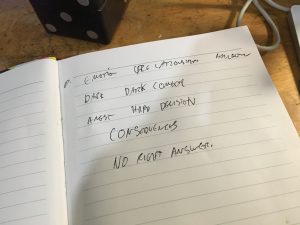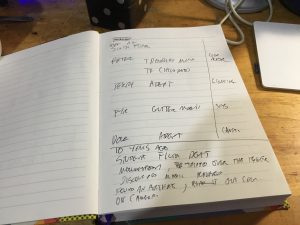One of the reasons for the slowdown in blogging stuff has been the number of things I’m doing that I don’t really blog about. One of those things is that I’m getting more into Tabletop RPG, especially running games. Recently I read and fell in lust for the new edition of Unknown Armies, a setting and system that runs on the tropes of Urban Fantasy & Horror, vast magics, personal relationships and health. It’s a brand new – and extensive – revision of the game, so there aren’t many existing guides to how it’s “supposed” to work. Some people have expressed interest in the process of creating and running the game, so this exists.
These are being posted some weeks after the session they’re about, because they’ll go into a bit of detail around how I built encounters, and I don’t want to affect the actual game that much. For the same reason, the metaplot will only be revealed as the players find it.
Unknown Armies is a weird setup for a game. There are aspects of an official setting, elements that exist in the world, bits of the metaverse, but the GM book – “Run” of the three book base set “Play”, “Run” and “Reveal” – goes through a detailed method of generating characters and a collaborative setting to put them in. It turns out – to nobody’s great surprise – that I’m a bit too much of a story-teller/control-freak to follow that completely, so I started off with a basic concept for a world with the expectation that if the players ended up circling around something I could either bend it to fit around them or abandon them for something else. These were a couple of ideas about the state of the “Cosmic” level (ie, the metaphysic), and a trigger at the Local level (the city the characters grew up in). The entirety of the local level was caused by seeing some solid-gold playing cards on Amazon, and buying a (cheaper) version. I then wrote a hook microfiction, and asked my Facebook feed if anyone was interested.
I was mildly surprised by how many people were.
Another game I’m involved in got put on hiatus as I was doing this, and I ended up giving the first few players from that who expressed interest first refusal, as well as my primary partner, primarily because I knew they’d have the same evening free. Wanting to keep my first GM attempt in A Long Time to a smaller group, I wasn’t able to invite the whole of the previous game to mine, and then failed to communicate well enough to avoid that looking like an exclusion. Lesson learned there is to either be more transparent or more opaque about finding people for games. A couple of my players had played previous editions, but none had touched 3rd Edition Unknown Armies.
Before the planning session I asked the players to fill out a Google Forms version of Bankeui’s Same Page Tool, to make sure our expectations weren’t vastly out of whack.

As I alluded to above, UA’s campaigns are a little more structured than most. The Run guide has a process for generating a world collaboratively with your players, the party then set an Objective. Sessions generally work towards completing that objective in mechanical form (succeeding nets you X% towards the goal, when you hit 100% you do the thing), and the Run guide starts with getting rough concepts for characters and then digging in to details and stats and universe links as the first session goes on. This worked fairly well, although relies a bit on circular knowledge, you need have a solid concept going in for the process to work well. The players settled on a shared backstory – an Incident during a shared sixth-form video project – and some paths for who they’d grown into in the ten years since.

The UA process brings with it locations and background NPCs, and in the end we got to most characters 4/5 complete, and one mostly in notes form. The universe had some locations and NPCs as defined in character backgrounds, and at the start of the next session we filled in those. We didn’t really get deep enough to define an objective for the group, though.
I’ve put the resulting initial universe (slightly retconned to add the character who joined during the prologue) up on Google Drive.
The collaborative game building system in Run worked well for creating a sketched out universe to go through, but as I say, it kind of needs a paradoxical combination of going in with a strong concept and a balanced party, but without the players having built out those characters at all so you can workshop the details. You also kind of need to know the game to some depth to be able to steer towards a good objective, which makes it hard to bootstrap people new to the game.
So we had a universe, some characters, and a vague idea of what to do next.
Next up: the first actual gameplay session.
(Header Image: A photo of London (from the Shard) tinted a menacing gold, original photo by Henry Be on Unsplash)






1 comment